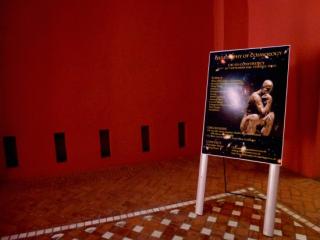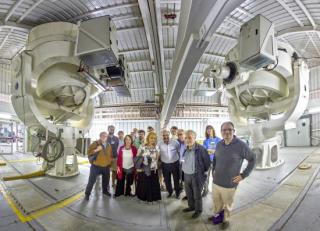This section includes scientific and technological news from the IAC and its Observatories, as well as press releases on scientific and technological results, astronomical events, educational projects, outreach activities and institutional events.
-
-
 As autumn began. with it came STARMUS, the multidisciplinary festival combining art, musio, astrophysics and space science, with which the Instituto de Astrofisica de Canarias, the IAC, is collaboratingAdvertised on
As autumn began. with it came STARMUS, the multidisciplinary festival combining art, musio, astrophysics and space science, with which the Instituto de Astrofisica de Canarias, the IAC, is collaboratingAdvertised on -
 The audiovisual presentation, designed to be projected in domes and planetaria has been designed by CETA-CIEMAT, IAC, and Eurocosmos, as part of a scientific popularization programme financed by the FECYT "Exploring the Solar System" makes available to the general public material which has previously been seen only through telescopes or via space probes; it will be distributed free of charge to any planetarium or projection theatre which asks for it. "Exploring the Solar System" will be shown in the majority of the planetaria in Spain, both fixed and mobile, so that it will be seen by anAdvertised on
The audiovisual presentation, designed to be projected in domes and planetaria has been designed by CETA-CIEMAT, IAC, and Eurocosmos, as part of a scientific popularization programme financed by the FECYT "Exploring the Solar System" makes available to the general public material which has previously been seen only through telescopes or via space probes; it will be distributed free of charge to any planetarium or projection theatre which asks for it. "Exploring the Solar System" will be shown in the majority of the planetaria in Spain, both fixed and mobile, so that it will be seen by anAdvertised on -
Today, Thursday 18th September at 20.00 in the "Espacion Fundación CajaCanarias", a dialogue between the astrophysicist of the IAC, and director of the Museum of Science and the Cosmos (MCC) Antonio Mampaso, and the science popularizer Dorion Sagan, with another astrophysicist of the IAC, Ignacio García de la Rosa, in the chair, will take place as the first encounter in the "Switch on the Cosmos" Forum, organized by the CajaCanarias FoundationAdvertised on
-
 This is what cosmologists and philosophers talk about when they get together.Advertised on
This is what cosmologists and philosophers talk about when they get together.Advertised on -
 Acompañados por el director y varios investigadores del Instituto de Astrofísica de Canarias (IAC), los participantes en el congreso Philosophy of Cosmology que se celebra en Tenerife accedieron a algunas de las instalaciones científicas, entre ellas el Experimento de microondas QUIJOTE, la Estación Óptica Terrestre (OGS), la Torre Solar al Vacío (VTT) y telescopios de divulgación en el entorno del Laboratorio Solar, una muestra representativa de diferentes telescopios y modos de observación presentes en este observatorio. Instantáneas de la visita al Observatorio del Teide Notas de prensa yAdvertised on
Acompañados por el director y varios investigadores del Instituto de Astrofísica de Canarias (IAC), los participantes en el congreso Philosophy of Cosmology que se celebra en Tenerife accedieron a algunas de las instalaciones científicas, entre ellas el Experimento de microondas QUIJOTE, la Estación Óptica Terrestre (OGS), la Torre Solar al Vacío (VTT) y telescopios de divulgación en el entorno del Laboratorio Solar, una muestra representativa de diferentes telescopios y modos de observación presentes en este observatorio. Instantáneas de la visita al Observatorio del Teide Notas de prensa yAdvertised on
